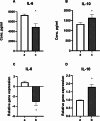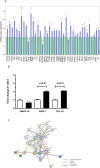Immunoregulatory properties of cell free DNA
- PMID: 40856801
- PMCID: PMC12381308
- DOI: 10.1007/s00018-025-05862-y
Immunoregulatory properties of cell free DNA
Abstract
Cell free DNA (cfDNA) is detectable at low concentrations in the plasma of healthy subjects and at high concentrations in disorders characterized by a high rate of necrotic events, such as tumors and vasculitis, leading to the release of necrotic DNA into the surrounding tissue and the bloodstream. Although cfDNA may act as a danger signal by binding to DNA sensors, triggering inflammation and immune responses, elevated cfDNA concentrations instead may exert immunoregulatory activities. Here, we show that exogenously administered cfDNA mediates immunoregulatory functions in vivo, in particular, it protects lupus-prone mice from disease progression and favors tumor growth in tumor-challenged mice. Our data suggest that cfDNA mediates immune regulatory activities by directly interacting with MHC class II molecules on antigen-presenting cells and through recruitment of regulatory T cells. This study unveils unprecedented biologic functions of cfDNA with significant pathogenic relevance and remarkable implications for the treatment of cancer patients.
Keywords: Autoimmune diseases; Cell free DNAs; Immune-modulations; Tumors.
© 2025. The Author(s).
Conflict of interest statement
Declarations. Ethics approval: This study was performed in line with the principles of the Declaration of Helsinki. Approval was granted by the local ethics committee (NCT02293707). All the procedures on animals were carried out by animal facilities qualified staff in accordance with the guidelines provided in Ministero della Salute D.lgs 26/2014. (pr. N. 778/2016-PR and 475/2018-PR). Consent to participate: Informed consent was obtained from all individual participants included in the study. Competing interests: The authors have no relevant financial or non-financial interests to disclose.
Figures






References
-
- Mandel P, Metais P (1948) Nuclear acids in human blood plasma. CR Seances Soc Biol Fil 142:241–243 - PubMed
-
- Van der Vaart M, Pretorius PJ (2008) Circulating DNA. Its origin and fluctuation. Ann N Y Acad Sci 1137:18–26. 10.1196/annals.1448.022 - PubMed
-
- Leon SA, Shapiro B, Sklaroff DM, Yaros MJ (1977) Free DNA in the serum of cancer patients and the effect of therapy. Cancer Res 37:646–650 - PubMed
-
- Jahr S, Hentze H, Englisch S et al (2001) DNA fragments in the blood plasma of cancer patients: quantitations and evidence for their origin from apoptotic and necrotic cells. Cancer Res 61:1659–1665 - PubMed
-
- Stroun M, Anker P, Maurice P, Lyautey J, Lederrey C, Beljanski M (1989) Neoplastic characteristics of the DNA found in the plasma of cancer patients. Oncology 46:318–322. 10.1159/000226740 - PubMed
MeSH terms
Substances
LinkOut - more resources
Full Text Sources
Research Materials

